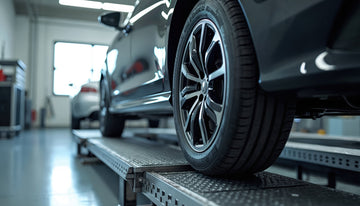Coilover suspension refers to a type of suspension system commonly used in vehicles, particularly in high-performance and sports cars. The term "coilover" is a combination of "coil spring" and "over," indicating that the coil spring is positioned over the damper (shock absorber) within a single unit. Coilover suspension is a type of aftermarket suspension system that replaces the factory shocks and springs with adjustable coilovers.
In a coilover suspension setup, the coil spring and the shock absorber are integrated into one assembly. This assembly is typically mounted between the vehicle's chassis and the wheel hub. The coil spring provides support and absorbs impacts from road irregularities, while the damper controls the movement and damping of the suspension.
What are the benefits of coilover suspension?
One of the main advantages of coilover suspension is its adjustability. The assembly usually features threaded collars or adjustable perches that allow the height of the vehicle to be modified. This adjustability allows for fine-tuning the ride height, which can impact handling, aerodynamics, and visual appearance.
Coilover suspension also provides the ability to adjust the damping characteristics. Some coilover setups have adjustable dampers, which allow for changing the stiffness or damping force of the shock absorber. This adjustability allows drivers to fine-tune the suspension to their preferences or specific driving conditions, improving performance, comfort, and handling.
Coilover suspension systems are popular among automotive enthusiasts and racing teams due to their versatility and adjustability. They provide a combination of spring support and damping control in a compact and integrated package, allowing for precise suspension tuning and improved overall performance.
How are coilovers installed?
While it is possible to install coilovers yourself, it is generally recommended to seek professional assistance or guidance, especially if you don't have prior experience with suspension systems.
Installing coilovers typically involves the following steps:
Preparation
Ensure the vehicle is securely lifted on a jack or lift, providing enough clearance to access the suspension components. It's important to take safety precautions and refer to the vehicle's manual or consult a professional if needed.
Removal of OEM suspension
Remove the existing suspension components, including the struts or shock absorbers, springs, and associated hardware. This usually involves disconnecting bolts, nuts, and any other fasteners securing the components to the vehicle.
Installation of coilovers
Install the pre-assembled coilovers into the suspension mounting points, ensuring they are properly aligned and securely fastened. This may involve reconnecting bolts, nuts, or other fasteners removed during the removal process.
Alignment and adjustment
Once the coilovers are installed, it's crucial to perform a wheel alignment to ensure proper suspension geometry and tire wear. Additionally, adjustments such as ride height, damping settings, and camber/caster may be made according to the manufacturer's guidelines or individual preferences. This step ensures optimal performance and handling.
Testing and fine-tuning
After installation, it's recommended to test the vehicle's suspension by taking it for a test drive. Pay attention to the handling, ride quality, and any unusual noises or vibrations. Fine-tune the coilovers' settings as needed to achieve the desired performance and comfort.
How can I maintain my coilover suspension?
Maintaining coilover suspension requires proper care and attention to ensure its longevity and optimal performance. Here are some tips for maintaining coilover suspension:
Regular Inspection
Perform regular visual inspections of the coilover suspension components. Look for any signs of damage, leaks, or excessive wear. Pay attention to the condition of the springs, shock absorbers, and adjuster mechanisms.
Cleanliness
Keep the coilover suspension components clean by regularly washing your vehicle. This helps prevent the buildup of dirt, debris, and corrosive substances that can damage the suspension components. Pay particular attention to cleaning the threaded collars and adjuster mechanisms to prevent them from getting stuck or seizing.
Lubrication
Apply lubrication to any moving parts or adjustment mechanisms as recommended by the manufacturer. This includes lubricating the threaded collars, adjuster rings, and any other adjustable suspension components. Follow the manufacturer's guidelines regarding the type and frequency of lubrication.
Adjustments
If your coilover suspension system has adjustable ride height or damping settings, and rebound (how quickly the suspension returns to its original position after being compressed) make adjustments carefully and within the recommended range. Avoid exceeding the recommended adjustment limits to prevent damage to the suspension components.The adjustment process can be time-consuming and requires some technical knowledge, but it's worth it for enthusiasts who want to optimize their vehicle's performance.
Regular Maintenance
Follow the maintenance schedule provided by the manufacturer. This may involve periodic servicing of the suspension components, such as replacing worn-out parts, checking the tightness of bolts and fasteners, and ensuring proper alignment.
Professional Service
If you notice any unusual noises, leaks, or handling issues with your coilover suspension, it is advisable to have it inspected and serviced by a professional technician. They can diagnose any potential problems and perform necessary repairs or replacements.
Remember to consult the specific maintenance guidelines provided by the manufacturer of your coilover suspension system, as maintenance procedures and intervals can vary. Following these maintenance practices will help ensure the longevity, performance, and safety of your coilover suspension system.





